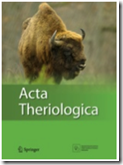Modelling the distribution of the European wild rabbit in fragmented environments
Ecoland members have investigated the factor affecting the occurrence of European wild rabbit in fragmented environments in a mountainous area of northwestern Spain (Gerês-Xurés Biosphere Reserve). The study has been led by Luis Tapia and conducted in collaboration with Jesús Domínguez and Maria Vidal from University of Santiago de Compostela.
Field survey was carried out by sampling the presence/absence of pellets in 237 plots (100 x 100 m) selected at random below an altitude of 800 m. For modeling purposes, we considered eight predictors related to vegetation, topography, human influence and heterogeneity. All predictors were obtained from Landsat-derived maps by using a Neuronal Artificial Neural Networks algorithm, and a Global Digital Elevation Model (GDEM). Generalized linear model were used to describe the occurrence of the European wild rabbit.
The information on habitat requirements of European wild rabbit in the area provides a good framework for determining the habitat requirements of this keystone species in mountainous ecosystems in northwestern Iberian Peninsula and confirms that digital data-based models can solve many of the problems associated with field data in wildlife modelling.





